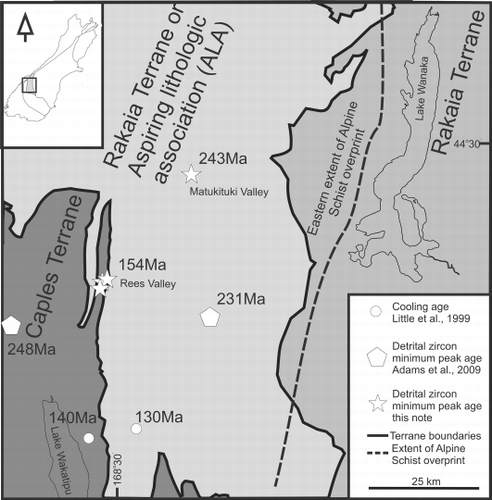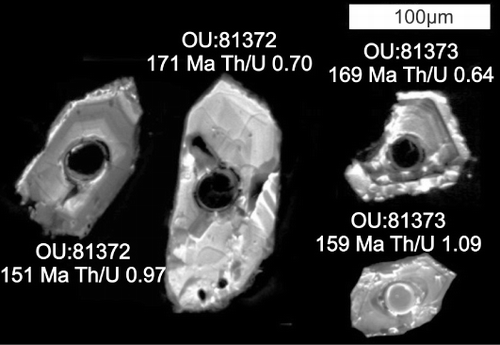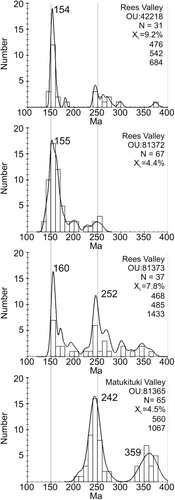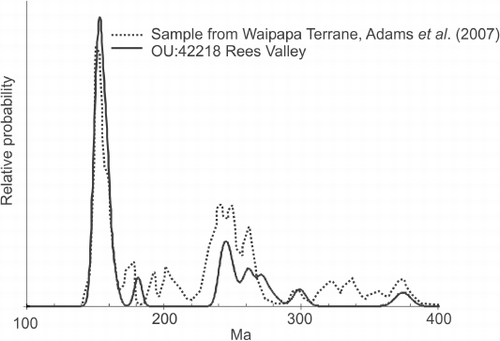Abstract
The youngest detrital zircon age groups from three samples within the Haast Schist in northwest Otago are Late Jurassic (154, 155, 160 Ma), as determined by laser ablation inductively coupled plasma mass spectrometry (LA-ICP-MS) analysis of U–Pb isotopes in individual zircons. It is inferred that this is the maximum age of sedimentation for these samples, which is within the range of ages for Haast Schist metamorphism (145–180 Ma). This maximum sedimentation age is at least 50 Ma younger than the previously inferred depositional ages for the Caples and Rakaia terranes which are the protoliths of Haast Schist. The zircon age populations within the samples are also different from those found within the Rakaia and Caples terranes, implying different sedimentary sources and possibly a different terrane. The detrital zircon populations are comparable to those found within the Waipapa Terrane in the North Island.
Introduction
The term ‘terrane’ was introduced to New Zealand geology by Coombs et al. (Citation1976) to refer to large Late Palaeozoic–Mesozoic tectonostratigraphic units with uncertain palaeogeographic relationships. In this 1976 paper, the ‘Torlesse’ Terrane (subsequently subdivided into Rakaia and Pahau terranes by Bishop et al. Citation1985) is clearly shown as allochthonous with respect to the rest of the terrane assembly, and uncertain displacements are suggested between several other terranes. Following the recognition of allochthonous terranes in western North America (Coney et al. Citation1980), the term ‘suspect terrane’ was defined as a tectonically bounded sequence of distinctive stratigraphy with uncertain palaeogeographic relationships to the continent. There have been many subsequent reviews and displacement models for New Zealand terranes e.g. Howell (Citation1980); Bishop et al. (Citation1985); Bradshaw (Citation1989); Vaughan et al. (Citation2005).
Two major tectonostratigraphic terranes, the Caples and Rakaia, are overprinted by and form the protolith of the Haast Schist, generally considered to have formed by convergence of the two terranes during the Middle–Late Mesozoic (Coombs et al. Citation1976; Wood Citation1978; Mortimer Citation1993; Little et al. Citation1999). Metamorphic grade increases towards the middle of the Haast Schist in Otago, from zeolite/prehnite-pumpellyite facies in the southwest (Caples Terrane) and northeast (Rakaia Terrane) to upper greenschist facies at the approximate contact of the two terranes (). Craw (Citation1984) recognised a zone in the central schist in northwest Otago that has a distinctive lithological composition with abundant metabasites, manganiferous cherts and pelitic sediments. He termed this the Aspiring lithologic association (ALA) and considered it a more distal assemblage between the Caples Terrane and more proximal parts of what is now the Rakaia Terrane (Little et al. Citation1999; Nishimura et al. Citation2000; Gray & Foster Citation2004) (). Norris & Craw (Citation1987) reviewed its character and structural relationships with the surrounding terranes, and concluded that it should be termed a suspect terrane in light of the probable allochthonous relationships of the terranes on either side. On the basis of geochemistry, Mortimer & Roser (Citation1992) suggested that it was part of the Rakaia Terrane; on the basis of isotope geochemistry, Adams & Graham (Citation1997) and Adams et al. (Citation2009) however argued that its closest correlative was the Waipapa Terrane of the North Island. Since in northwest Otago the ALA lies between the inboard Caples Terrane, derived mostly from an oceanic island arc, and the outboard Rakaia Terrane, derived largely from the active margin of the Gondwana continent (Adams et al. Citation2009), its status and history are critical to understanding terrane accretion along the SW Pacific portion of the Gondwana margin.

Detrital zircons are unique in their ability to date and fingerprint the protoliths of the Haast Schist due to the destruction of the stratigraphy by metamorphism and the rarity of fossils within these terranes. Adams et al. (Citation2007, Citation2009) found that the youngest detrital zircon population in a sample is close to the inferred depositional age in the Mesozoic terranes of New Zealand, due to their proximity to active margins.
In Otago, the Haast Schist is divided into the Otago Schist and Alpine Schist. The Otago Schist was metamorphosed in the Jurassic and exposed in the Cretaceous, whereas the Alpine Schist may have been metamorphosed as late as the Cretaceous and has been exposed in the last five million years from uplift along the Southern Alps (Mortimer Citation2000). The ALA has been overprinted by both the Otago and Alpine schist metamorphism (). In this note, we report detrital zircon age spectra from samples from the Haast Schist and compare them with published data from the Caples and Rakaia terranes and other terranes in New Zealand.
Method
Three samples of schist were collected from Muddy Creek in the Rees Valley (OU:42218, OU:81372, OU:81373) and one sample from the Matukituki Valley north of Aspiring Hut (OU:81365) (). Each sample was processed separately. Samples were crushed and sieved to a fraction between 50 and 250 µm. The laser ablation inductively coupled plasma mass spectrometer (LA-ICP-MS) at the Research School of Earth Sciences, Australian National University was used, following procedures described most recently by Sagar & Palin (Citation2011). All zircons within the microscope field of view were hand-picked and mounted, whether they were definite or probable zircons. Crystals were set and polished in an epoxy mount and analyses were only taken from the core of each mounted crystal (). The standard zircon TEMORA2 and NIST610 glass were used for correction of depth-related inter-element and isotopic fractionation of Pb, Th and U and concentration determination, respectively.

Spot analyses with internal mean square weighted deviate (MSWD) values in excess of 10 were rejected from further consideration. Concordance was calculated on the basis of agreement between 207Pb/235U and 206Pb/238U dates within their reported 1σ internal errors. Analyses that were more than 10% discordant were not included in the age calculation.
Results
Detrital zircons have different age patterns between the Rees Valley and Matukituki Valley. The three Rees Valley (OU:42218, OU:81372, OU:81373) samples have principal age peaks of 154, 155 and 160 Ma and smaller peaks around 250 Ma (, ). The ratio of c. 150 Ma and c. 250 Ma ages varies between samples. One of the Rees Valley samples (OU:81372) has no zircon ages older than 300 Ma (). The Matukituki Valley sample (OU:81365) has prominent age peaks at c. 250 and c. 350 Ma and two zircons from the Precambrian. Zircons less than 200 Ma are completely absent from this sample.

Table 1 Detrital zircon samples from the Rees and Matukituki valleys. Age of peaks include all analyses within the specified age range with less than 10% discordances. For example, the age given for OU:42218 includes all viable analyses with a date younger than 180 Ma. New Zealand Transverse Mercator grid references.
Discussion
Do Jurassic zircon ages represent igneous or metamorphic events?
The Jurassic zircons from the Rees Valley samples are of similar age to the metamorphism of the Haast Schist in which they are found (Little et al. Citation1999); it is therefore important to know if these zircons are igneous or metamorphic in origin. Zircons from granulite facies rocks can develop metamorphic rims (Rubatto et al. Citation2001), but the Haast Schist in the locations sampled attain only upper greenschist facies (Mortimer Citation2000) and no metamorphic rims were observed. Discordance does not vary between the Jurassic and Triassic dates within the Rees Valley samples so Pb loss, while possibly present, does not explain the Jurassic dates. These zircons show typical igneous structure when viewed with cathodoluminescence (Corfu et al. Citation2003) () and have typical igneous Th/U ranges of greater than 0.1 in all but two analyses (Ahrens et al. Citation1967; Hoskin & Black Citation2000; Rubatto et al. Citation2001). For the above reasons it is inferred that they eroded from an igneous source and were transported with other sediment. The maximum age of deposition of the Rees Valley samples is therefore Late Jurassic. This is c. 90 Ma younger than the Triassic maximum age of deposition of the Matukituki Valley sample.
Comparison of Rees Valley detrital zircons with other terranes
The Rees Valley sample location was identified as the Caples Terrane from whole-rock geochemistry performed on the same meta-psammite lens by Mortimer & Roser (Citation1992). However, the samples from the Rees Valley reported here have different detrital zircon age distributions to the Caples and Rakaia terranes (Adams et al. Citation2007, Citation2009). The most important difference is the group of zircons of Jurassic age that limit the depositional age of Rees Valley samples to younger than c. 154 Ma. In comparison, the youngest zircon populations from the Caples and Rakaia terranes are 210–220 Ma (Adams et al. Citation2007, Citation2009; Jugum Citation2009). The 500–600 Ma detrital zircon peak which is usually observed in the Rakaia Terrane is also missing in the samples from the Rees and Matukituki valleys, as noted by Adams et al. (Citation2009) for their ALA sample. The difference in detrital zircon ages implies that these samples have a different sedimentary source to the known Caples and Rakaia terranes.
The ALA has been correlated with the Waipapa Terrane by Adams & Graham (Citation1997) and Adams et al. (Citation2009) as they share the same tectonostratigraphic position across the Alpine Fault and a similar Sr isotopic signature. Geochemically, the Waipapa Terrane overlaps with both the Caples and Rakaia terranes with respect to Si, K, Na and other major-element discriminants (Coombs et al. Citation2000). Lithologically, the Rees Valley samples are from an area where pelites are common and have been mapped as part of the ALA previously (Craw Citation1984). The Waipapa Terrane also shares the abundance of chert and basic volcanic rock associated with the ALA (Black Citation1994; Adams & Maas Citation2004).
The complete detrital zircon age pattern from the Jurassic Rees Valley sample (OU:42218) is also very similar to the representative Jurassic Waipapa Terrane sample in Adams et al. (Citation2007) from north Auckland (). Zircons older than Jurassic age in the Rees Valley samples have a similar age distribution to those in the Matukituki Valley sample (). The Skippers River sample (ALA) and Waipapa and Caples terranes samples of Adams et al. (Citation2009) all show these peaks at 250 Ma and a lack of Cambrian zircons, common in Rakaia Terrane samples.

The protolith lithology, geochemistry and detrital zircon age distribution of the eastern Rees Valley schist overlap with the Waipapa Terrane. It is therefore suggested here that the Waipapa Terrane does not stop at the Alpine Fault in Nelson, but extends into Otago. It remains possible, however, that the Rees Valley samples are from a Jurassic component of the Caples Terrane or an as yet unknown terrane within the Haast Schist. These possibilities remain open as detrital zircons have only provided a maximum age on the known Caples Terrane (Adams et al. Citation2009) and terrane boundary faults are obscured by the Haast Schist.
Consequences of detrital Jurassic zircons in the Haast Schist
The estimated age of peak metamorphism of the Haast Schist in Otago varies within the range 145–160 Ma (Gray & Foster Citation2004) and 170–180 Ma (Little et al. Citation1999). The maximum sedimentation age for the Rees Valley samples presented here precludes it being overprinted by the Jurassic metamorphism or limits the age of that metamorphism to after c. 154 Ma. The cooling ages given by Little et al. (Citation1999) for samples near the Rees Valley samples are 140 and 130 Ma (). This allows c. 14 Ma for the zircon crystallisation, erosion, deposition, metamorphism and cooling of the Rees Valley samples. This continues the trend of the youngest detrital zircon ages being close to sedimentation ages for Mesozoic New Zealand terranes (Akdams et al. Citation2007, Citation2009).
If the ALA is the extension of the Waipapa Terrane southeast of the Alpine Fault (Adams & Graham Citation1997), then it can be used to shed further light on the terrane relationships within the Haast Schist. In Northland, the Waipapa Terrane is a continuous belt east of the Caples Terrane and generally does not exhibit a penetrative foliation characteristic of the Haast Schist in the South Island (Black Citation1994). In Otago, however, the ALA is structurally beneath the Caples Terrane and within the structural centre of the exposed Haast Schist (Norris & Craw Citation1987; Little et al. Citation1999; Mortimer Citation2000, Citation2003; ). The new zircon data reinforce the distinctive nature of the ALA within the Haast Schist and point to a correlation with part of the Waipapa Terrane on the northwest side of the Alpine Fault. The ages also indicate a final accretion of these terranes sometime after the Late Jurassic, placing constraints on the age of the Haast Schist metamorphic overprint. The presence of older metamorphic ages in parts of the Rakaia Terrane (Little et al. Citation1999; Adam et al. Citation2009) suggests that some metamorphism occurred during assembly of the terrane before its final accretion along the Gondwana margin. Alternatively, during the accretion that led to the metamorphic and structural overprint of the Haast Schist, the ALA may have been underplated beneath the already partially metamorphosed Rakaia and Caples terranes. The underplating of the ALA may have been part of the exhumation process that led to the cooling of the overlying Caples and Rakaia terranes in the Early Cretaceous.

Supplementary files
Supplementary file 1: Tables S1. Tables 1–12 contain U–Th–Pb isotope data, Tables 1–2 contain zircon analyses for OU:42218, Tables 2–6 for OU:81365, Tables 7–10 for OU:81372 and Tables 11–12 for OU:81373.
tnzg_a_815639_sm6763.docx
Download MS Word (101.9 KB)Acknowledgements
Dave Craw contributed useful suggestions on the Haast Schist and a sample from his PhD was analysed for this paper. We are grateful to Nick Mortimer for conversations on the terranes in Otago and comments on how to improve this manuscript. James Scott provided assistance with zircon separation and analysis. We would also like to thank the many members of staff in the Department of Geology of the University of Otago and GNS Science, Dunedin. The manuscript was also improved by suggestions from two anonymous reviewers.
References
- Adams CJ, Graham IJ 1997. Age of metamorphism of Otago Schist in eastern Otago and determination of protoliths from initial strontium isotope characteristics. New Zealand Journal of Geology and Geophysics, 40: 275–286. 10.1080/00288306.1997.9514760
- Adams CJ, Maas R 2004. Age/isotopic characterisation of the Waipapa Group in Northland and Auckland, New Zealand, and implications for the status of the Waipapa Terrane. New Zealand Journal of Geology and Geophysics, 47: 173–187. 10.1080/00288306.2004.9515046
- Adams CJ, Barley ME, Maas R, Doyle MG 2002. Provenance of Permian-Triassic volcaniclastic sedimentary terranes in New Zealand: evidence from their radiogenic isotope characteristics and detrital mineral age patterns. New Zealand Journal of Geology and Geophysics, 45: 221–242. 10.1080/00288306.2002.9514970
- Adams CJ, Campbell HJ, Griffin WL 2007. Provenance comparisons of Permian to Jurassic tectonostratigraphic terranes in New Zealand: perspectives from detrital zircon age patterns. Geological Magazine, 144: 701–729. 10.1017/S0016756807003469
- Adams CJ, Campbell HJ, Griffin WL 2009. Tracing the Caples Terrane through New Zealand using detrital zircon age patterns and radiogenic isotope signatures. New Zealand Journal of Geology and Geophysics, 52: 223–245. 10.1080/00288300909509888
- Ahrens L, Cherry R, Erlank A 1967. Observations on the Th-U relationship in zircons from granitic rocks and from kimberlites. Geochimica et Cosmochimica Acta, 29: 711–716. 10.1016/0016-7037(65)90064-5
- Andersen, T 2005. Detrital zircons as tracers of sedimentary provenance: limiting conditions from statistics and numerical simulation. Chemical Geology, 216: 249–270. 10.1016/j.chemgeo.2004.11.013
- Bishop DG, Bradshaw JD, Landis CA 1985. Provisional terrane map of South Island, New Zealand. In D. G. Howell ed. Tectonstratigraphic terranes of the Circum-Pacific region, 1. Houston, Texas, Circum-Pacific Council for Energy and Resources. Pp.515–521.
- Black PM 1994. The ‘Waipapa Terrane’, North Island, New Zealand: subdivision and correlation. Geoscience Reports of Shizuoka University, 20: 55–62.
- Bradshaw JD 1989. Cretaceous geotectonic patterns in the New Zealand region. Tectonics, 8: 803–820. 10.1029/TC008i004p00803
- Coney PJ, Jones DL, Monger JWH 1980. Cordilleran suspect terranes. Nature, 288: 329–333. 10.1038/288329a0
- Coombs DS, Landis CA, Norris RJ, Sinton JM, Borns DJ, Craw D 1976. The Dun Mountain Ophiolite Belt, New Zealand, its tectonic setting, constitution, and origin, with special reference to the southern portion. American Journal of Science, 276: 561–603. 10.2475/ajs.276.5.561
- Coombs DS, Landis CA, Hada S, Roser, B, Suzuki T, Yoshikura S 2000. The Chrystalls Beach-Brighton block, southeast Otago, New Zealand: Petrography, geochemistry, and terrane correlation. New Zealand Journal of Geology and Geophysics, 43: 355–372. 10.1080/00288306.2000.9514893
- Corfu F, Hanchar JM, Hoskin PW, Kinny P 2003. Atlas of zircon textures. Reviews in Mineralogy, 53: 469–500. 10.2113/0530469
- Craw D 1984. Lithologic variations in Otago Schist, Mt. Aspiring area, Northwest Otago, New Zealand. New Zealand Journal of Geology and Geophysics, 27: 151–166. 10.1080/00288306.1984.10422524
- Dodson MH, Compston W, Williams IS, Wilson JF 1988. A search for ancient detrital zircons in Zimbabwean sediments. Journal Geological Society of London, 145: 977–983. 10.1144/gsjgs.145.6.0977
- Gray DR, Foster DA 2004. 40Ar/39Ar thermochronologic constraints on deformation, metamorphism and cooling/exhumation of a Mesozoic accretionary wedge, Otago Schist, New Zealand. Tectonophysics, 385: 181–210. 10.1016/j.tecto.2004.05.001
- Hoskin PWO, Black LP 2000. Metamorphic zircon formation by solid-state recrystallization of protolith igneous zircon. Journal of Metamorphic Geology, 18: 423–439. 10.1046/j.1525-1314.2000.00266.x
- Howell DG 1980. Mesozoic accretion of exotic terranes along the New Zealand segment of Gondwanaland. Geology, 8: 487–491. 10.1130/0091-7613(1980)8<487:MAOETA>2.0.CO;2
- Jugum D 2009. A tectonic synthesis of the Dun Mountain Ophiolite Belt. Unpublished PhD thesis, University of Otago, Dunedin, New Zealand. 346p.
- Little TA, Mortimer N, McWilliams M 1999. An episodic Cretaceous cooling model for the Otago-Marlborough Schist, New Zealand, based on 40Ar/39Ar white mica ages. New Zealand Journal of Geology and Geophysics, 42: 305–325. 10.1080/00288306.1999.9514848
- Mortimer N 1993. Jurassic tectonic history of the Otago Schist, New Zealand. Tectonics, 12: 237–244.
- Mortimer N 2000. Metamorphic discontinuities in orogenic belts: example of the garnet-biotite-albite zone in the Otago Schist, New Zealand. International Journal of Earth Sciences, 89: 295–306. 10.1007/s005310000086
- Mortimer N 2003. A provisional structural thickness map of the Otago Schist, New Zealand. American Journal of Science, 303: 603–621. 10.2475/ajs.303.7.603
- Mortimer N, Roser B 1992. Geochemical evidence for the position of the Caples-Torlesse boundary in the Otago Schist, New Zealand. Journal of the Geological Society of London, 149: 967–977. 10.1144/gsjgs.149.6.0967
- Mortimer N, Davey FJ, Melhuish A, Yu J, Godgrey NJ 2002. Geological interpretation of a deep seismic reflection profile across the Eastern Province and Median Batholith, New Zealand: crustal architecture of an extended Phanerozoic convergent orogen. New Zealand Journal of Geology and Geophysics, 45: 349–363. 10.1080/00288306.2002.9514978
- Nishimura Y, Coombs D, Landis C, Itaya T 2000. Continuous metamorphic gradient documented by graphitization and K-Ar age, southeast Otago, New Zealand. The American Mineralogist, 85: 1625–1636.
- Norris RJ, Craw D 1987. Aspiring Terrane: An oceanic assemblage from New Zealand and its implications for terrane accretion in the Southwest Pacific. In E. C. Leitch and E. Scheibner eds., Terrane accretion and orogenic belts, 19. Washington, DC, American Geophysical Union. Pp. 169–177.
- Rubatto D, Williams IS, Buick IS 2001. Zircon and monazite response to prograde metamorphism in the Reynolds Range, central Australia. Contributions to Mineralogy and Petrology, 140: 458–468. 10.1007/PL00007673
- Sagar MW, Palin JM 2011. Emplacement, metamorphism, deformation and affiliation of mid-Cretaceous orthogneiss from the Paparoa Metamorphic Core Complex lower-plate, Charleston. New Zealand Journal of Geology and Geophysics, 54: 273–289. 10.1080/00288306.2011.562904
- Turnbull IM 2000. Geology of the Wakatipu area. Institute of Geological & Nuclear Sciences 1:250 000 Geological Map 18. Lower Hurt, Institute of Geological & Nuclear Sciences.
- Vaughan APM, Leat PT, Pankhurst RJ 2005. Introduction. In Vaughan APM, Leat PT, Pankhurst RJ eds. Terrane processes at the margins of Gondwana. Geological Society, London, Special Publications, 246: 1–21.
- Wood B 1978. The Otago schist megaculmination: Its possible origins and tectonic significance in the Rangitata orogen of New Zealand. Tectonophysics, 47: 339–368. 10.1016/0040-1951(78)90038-0